1- Introduction
Japan is a country apart. It’s a saying that we often hear. But there is something true about it.
It is an archipelago; its History is special (it was cut off from the world for nearly 300 years); the conception of its population for life is very peculiar; Japan’s vision of the outside world is very peculiar.
Japan’s economic boom was blazing twice in less than 150 years: as soon as it emerged from its isolation (1868), it caught up with the Western world in less than two decades and joined the club of World powers of the late 19th and 20th century:
(1895 it defeated China, in 1905 it defeated Russia, then started the occupation of almost all of South Asia 1931-1945).

We can compare this map with the actual situation of the “economic conquests”
Japan is defeated and wiped out by a fierce war that ends with two atomic bombings (1945), it gets up after barely 7 years and in 1964 organizes Olympic Games which is a sign of a good economic health. And few years ago Japan was the second rank economic.
2- Let’s now look at the Japan’s Strategic Diplomacy
2.1 Japan is looking to ensure its national interests (where)
- in the political and security domain,
- in the economic domain,
- in continuing to maintain and develop an international order
2.2 All that is based on fundamental values for Japan
- freedom
- democracy
- human rights
- rules of law
To ensure all the above objectives Japan conducts a strategic diplomacy through the Ministry of Foreign Affairs (MoFA).
2.3 Japan-U.S. Alliance
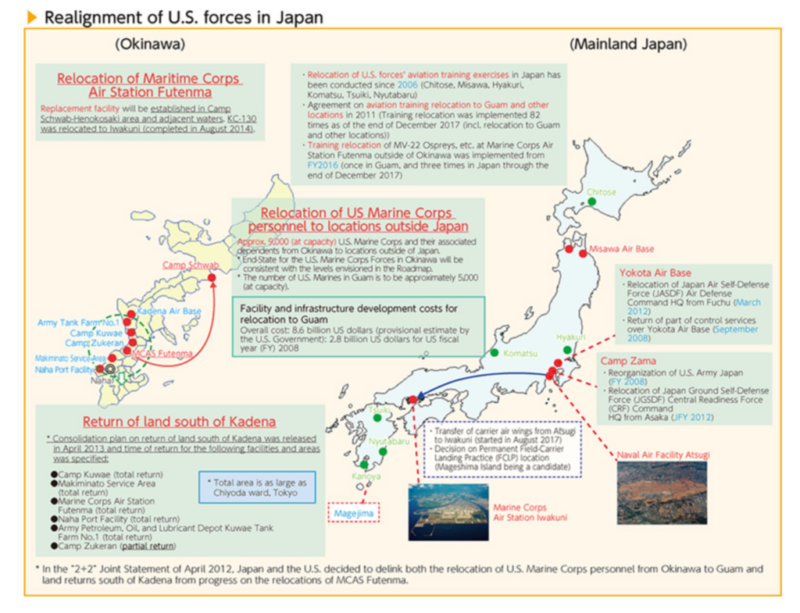 The Alliance between Japan and the United States is the cornerstone of Japan’s diplomacy and security. It also plays an important role in regional and international peace and prosperity.
The Alliance between Japan and the United States is the cornerstone of Japan’s diplomacy and security. It also plays an important role in regional and international peace and prosperity.
This Alliance is becoming increasingly important because the security environment surrounding Japan is becoming increasingly important.
The two countries, despite the Trump presidency claim to be 100% OK on the issue of North Korea
Their commitment to the region is unwavering. And we must note that the presence of American bases, which form the basis of Western defense in this region of the world.
The two countries share the same goal: work together to implement a strategy for the creation of an “Indo-Pacific Free Trade Area”.
This was before the election of Trump.
But even if this strategy is not called into question, it is necessary to wait until the end of the negotiations of the multiple multilateral agreements questioned by the American President before concluding its good end[1] (which I will elaborate later).
The whole relationship with the United States will be left for the end, because the shadow of Washington is present throughout the Japanese geopolitical strategy.But Japan must also take into consideration the changes in the international situation and react to those changes.
We can find six priorities of Japan’s foreign policy:
- Reinforcing the Japan-U.S. Alliance and promote the networking of allies and friendly nations;
- Enhancing relations with neighboring countries;
- Promoting economic diplomacy;
- Contributing to the resolution of global issues;
- Contributing to the peace and stability of the Middle East;
- Promoting “Free and Open Indo-Pacific Strategy.”
3- Overview (from Japan) of the international situation
Any observer can realise that the security environment surrounding Japan is facing extremely severe conditions:
Six fields are concerned by Japanese diplomacy:
- 1- Diversification and complexity of geopolitical threats;
- 2- The Global Economic Trend;
- 3 – The security of Japanese citizens around the world;
- 4- Energy sources and Middle-East;
- 5. Disputes and Litigations;
- 6. The weight of history or the influence of Japan’s colonial past;
3.1. – Diversification and complexity of geopolitical threats
- 1.1. We have the increasingly tense situation in North Korea
During last two years, the unprecedented frequency of ballistic missile launches, nuclear tests and other provocations by North Korea has created a real threat to the archipelago.
But also highlighted the risks associated with the transfer, the proliferation of weapons of mass destruction and the possibility that terrorist organizations could acquire and use them.
This poses a major threat to the entire international community, but especially to Japan.
In 2017, North Korea carried out the sixth nuclear test and launched 15 ballistic missiles, two of which flew over Japan. The establishment of nuclear capabilities and missiles by North Korea poses a grave, imminent and unprecedented threat to the peace and stability of Japan and the international community. Japan is cooperating closely with the United States and South Korea, but also with the countries concerned, including China and Russia, to exerce pressure on North Korea by all means available to convince this country to give up the weapon nuclear.
However, Japanese diplomacy remains skeptical about the results of the inter-Korean summit of April 27, 2018 and the Trump-Kim Jung-Un summit in early June because the results despite the appeasement, tangible on the demarcation line, remain far from the objectives of the international community.
Another problem is part of the litigation with North Korea.
The fundamental dogma of Japanese diplomacy is that the normalization of its relations with North Korea is impossible without solving the problem of abductions of Japanese citizens in the seventies.
Japan consistently requests North Korea to provide a full report of all abduction cases, and ensure the immediate return of survivors to the country.
- Republic of Korea (South Korea)
Despite various tensions between Japan and South Korea (which we will see later in this presentation), the majority of the population of both countries is convinced that their country’s relations are extremely important. If for the moment the relations remain cold on the diplomatic level, on the economic level[2] a break in the relations between the two nations would be absurd as long as the economies of the two countries seem linked.
Under the terms of the treaty signed on June 22, 1965, Japan recognizes the Republic of Korea as the only state representing the entire Korean peninsula.
The treaty also provided for the payment of $ 300 million of Japanese development assistance to South Korea, plus another $ 500 million of bank loans.
The dispute over the delimitation of territorial waters is partially settled by the creation of a common fishing zone, but the question of the sovereignty of the Dokdo(Takeshima) Islands remains.
At that time, the normalization of diplomatic relations between South Korea and Japan had created a strong opposition in both countries.
Beyond rivalries and injuries, South Korea is above all a strong economic partner for Japan, its second largest trading partner after China, for spare parts and many other high-tech products. Japan, for its part, still needs South Korea, its third largest trading partner after China and the United States, to regain momentum in growth as well as to face the North Korean nuclear problem.
- The emergence of China and India as major powers
- China
Last year in 2017 marked the 45th anniversary of the establishment of diplomatic relations between Japan and China. The relationship between these two countries is very important for the stability of the region and the global stability.
This relationship is based on very strong economic relations as well as interpersonal and cultural exchanges.
In 2017, the number of Chinese tourists visiting Japan was about 8 million (Japan National Tourism Organization -JNTO).
Problems exist between Japan and China, as neighboring countries but the difficulty varies.
Despite this, China is reinforcing its military forces beyond defensive necessities and embarking on unilateral attempts to change the status quo of maritime borders in South Asia.
China is taking unilateral action and attempting to change the status quo by force in the South and East of the China Sea and in the airspace of these areas, based on its own claims, which are incompatible with international law.
- In the East China Sea, China does not recognize Japanese sovereignty over the Senkaku Islands. Beijing sends its ships and naval aircraft into what Tokyo considers to be its territorial waters.
- In addition, China continues to develop the unilateral exploitation of resources in disputed maritime areas by other countries by a delimitation of exclusive economic zones and continental shelves is not yet fixed.
- In the South China Sea, China has started at large-scale construction on the coral islands. Beijing builds outposts for military purposes.
Japan notes that China is progressively transforming the disputed bases of the South China Sea into military bases.
Till now Tokyo is not reacting.
- India
With India Japan does not yet see a “geostrategic friction” (not to say threat … let’s say géostrategic competition).
Japan has significantly advanced bilateral relations with New Delhy, particularly in the area of economic cooperation (eg high-speed rail between Mumbai and Ahmedabad).
The relationship between Japan and India, more particularly known as “the most potential bilateral relationship in the world”, deserves to be highlighted.
Japan is working with India to promote prosperity at the regional and global levels, including by cooperating in the creation of a free and open Indo-Pacific region based on the “Special and Global Strategic Partnership”.
The increase of “gray-zone” situations that are neither pure peacetime nor contingencies over territorial sovereignty
All are concerning the territorial sovereignty in particular in the Asia region, this engages the responsibility of Japan in this very important zone for its economy and stability.
3.1.5. Taiwan
Among the countries (or areas) that are of geostrategic interest for Japan, we have Taiwan in the first place.
Taiwan is an important partner of Japan for several reasons.
Even if, to comply with the requirements of Beijing, there is no exchange of embassies, but only representative offices.
Cooperation is economic, cultural and touristic, and recently a customs cooperation agreement has been concluded.
We will see later that good relations with Taiwan helps reinforcing Japan’s position in the dispute over the Senkaku Islands with China.
3.2. The Global Economic Trend
- The lack of cooperative security frameworks
Japan, which sees the strategic environment surrounding Asia-Oceania region changing, is trying to build cooperation to reinforce its relations with the countries of this region.
Let’s start by studying the effects of the so-called “Look East” policy, which is at the root of good bilateral relations between Japan and the ASEAN countries in the first place
3.2.1. Singapore
Japan attaches great importance to its relations with Singapore in order to guarantee freedom of navigation in the Strait of Malacca.
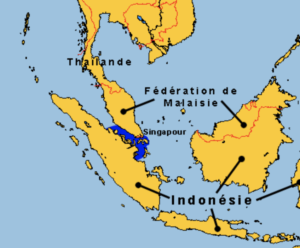 Strait of Malacca has a strategic importance as the main oil supply route for two of the world’s major consumers, Japan and China.
Strait of Malacca has a strategic importance as the main oil supply route for two of the world’s major consumers, Japan and China.
In addition, Singapore is an important financial center.
3.2.2. Malaysia
Malaysia, which maintains steady growth, is preparing to join the group of advanced countries by 2020
The cooperation with Malaysia is mainly economic, Japan is the largest investor in Malaysia and 1,400 Japanese companies operate in Malaysia.
The Look East Policy Program, implemented in 2012, has enabled about 16,000 people to study or have been trained in Japan so far.
3.2.3. Brunei
It is a large exporter of energy products.
About 60% of Brunei’s liquefied natural gas (LNG) exports go to Japan, and Brunei’s LNG accounts for about 5% of total LNG imports into Japan, making Brunei an important country for stable supply for Japan.
Japan has established cooperation with Brunei to help it in developing its economy, to avoid excessive dependence on energy resources.
Indeed, the economic growth rate has declined in recent years due to the drop in crude oil and natural gas prices.
3.2.4. Indonesia
The geostrategic position of Indonesia pushes Japan to strengthen its relations with “the largest Muslim country”.
The demographic weight of the Indonesian archipelago is to be considered face to the claims of China on the South China Sea.
To all this is added economic cooperation (oil, maritime wealth and raw materials) in terms of maritime infrastructure.
3.2.5. The Philippines
Since last year 2017, the Philippines and Japan consider themselves as “strategic partners”.
A bilateral cooperation program for the next five years has been published this year. Japan and the Philippines are strengthening their cooperation in various fields, including civilian infrastructure development (metro projects) and the fight against illicit drugs, aid to Mindanao (fight against Muslim separatists).
But Japan is worried about the warming of relations between Beijing and Manila.
This new Indonesian policy seems a balance of Manila’s position between Washington and Beijing, and is less directed against Tokyo.
Moreover, China’s claims in South China Seas go against the interests of the Philippines.
- The rising of the protectionism as a backlash to the advance of globalization.
- In addition, the international order based on the principle of multilateral agreements is falling apart.
Three countries are at the center of Japan’s diplomatic interest: Thailand, Cambodia and very recently Vietnam.
3.2.6.1. Thailand
Thailand is located in the center of the Mekong region and has a “strategic partnership” relationship with Japan.
Many Japanese companies have relocated to Thailand their productions and investments are very important in this country.
Currently Thailand is an essential part of the global supply chains of the Japanese economy.
3.2.6.2. Cambodia
For Japan, Cambodia is strategically located in the Southern Economic Corridor and plays a key role in strengthening the communications channels in the Mekong region.
Japan has been actively engaged in Cambodia, particularly in the Cambodian peace process of the late 1980s and its process of reconstruction and subsequent development. (Peacekeeping force)
It is helping this country to become a middle-income country in the upper 2030s.
3.2.6.3. Vietnam
The importance of Vietnam for Japan lies in its geographical position near the South China Sea and the long border with China. Hence the geopolitical importance of this country.
It is the third largest population in Southeast Asia and is growing steadily and Viet Nam is emerging as a promising market.
This is achieved through enhanced bilateral cooperation, and the conclusion of multilateral agreements, such as Japan-ASEAN, Asia-Pacific Economic Cooperation (APEC), as well as bilateral and trilateral agreements, such as the:
Republic of Korea ,Japan-China agreements.
Japan-United States, Australia,
Japan-Australia-India.
The further integration, prosperity, and stability of the Association of Southeast Asian Nations (ASEAN) are vital for the peace and stability of the region. Japan is continuing to support the centrality and unity of ASEAN, and teinforce its relationship with ASEAN and each of the ASEAN countries.
ASEAN
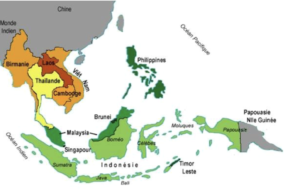 The Association of Southeast Asian Nations is a political, economic and cultural organization of countries in Southeast Asia.
The Association of Southeast Asian Nations is a political, economic and cultural organization of countries in Southeast Asia.
It was launched by the “Declaration of Bangkok” on August 8, 1967 by five countries:
Indonesia; Malaysia; The Philippines; Singapore; Thailand;
Brunei joined January 8, 1984
Vietnam the 1995
Laos, July 23, 1997
Burma 23 July 1997
Cambodia on April 30, 1999
APEC
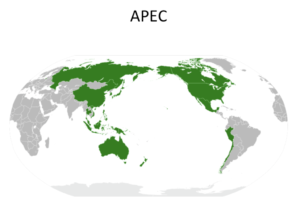 Asia-Pacific Economic Cooperation is an intergovernmental economic forum aimed at facilitating the economic growth, cooperation, trade and investment of this great region.
Asia-Pacific Economic Cooperation is an intergovernmental economic forum aimed at facilitating the economic growth, cooperation, trade and investment of this great region.
It consists of the following countries:
Canada, United States, Mexico, Chile, Peru, Australia, New Zealand, Papua New Guinea, Russia, China, Japan, Taiwan, South Korea, and the 10 countries of Asean.
These 23 Pacific countries account for more than half of the world’s economic activity.
Apec (Asia-Pacific Economic Cooperation Forum) countries account for a total of 56% of global GDP.
Indeed:
 It brings together the three major economies of the planet (United States, China, Japan)
It brings together the three major economies of the planet (United States, China, Japan)
Heavyweights of raw materials exporters (Australia, Russia, Canada) of oil (Indonesia, Brunei, Russia and the United States).
Assembly industries countries (ASEAN countries, Taiwan, Korea, Mexico).
The Apec countries were working on a free trade area … but…
There is competition between two projects:
1- A “Trans-Pacific Partnership” (TPP) bringing together Australia, New Zealand, Chile, Malaysia, Brunei, Vietnam, Peru, Singapore, Canada and Mexico alongside the United States and Japan without China. (40% of global GDP).
2- China, for its part, is working on an exclusively Asian competitor project, bringing together 16 countries, without the United States.
TPP
Japan is now the great builder of TPP “Trans-Pacific Partnership Agreement” (TPP) that will come into effect at the end of this year, despite the opposition of Donald Trump.
United States was its main driving force.
The survival of the agreement is a triumph for Japanese diplomacy.
This development could surprise: because Japan joined the negotiations late.
The Japanese government appears today as the leader of free trade in the Pacific zone.
The economic benefits of the TPP for Japan are, of course, significant. The agreement, which includes significant tariff cuts and measures to protect intellectual property, the environment and labor rights, should boost growth by encouraging foreign investments in the Archipelago and offer new business opportunities for Japanese companies.
Its strategic importance, however, is taken into consideration in the calculations of Tokyo.
TPP was initially a way to reinforce the alliance with the United States, which continues to be the basis of the Japanese security policy.
With the US withdrawal, the deal changes direction and becomes a way to counter the pressures of Donald Trump’s administration.
The Japanese government can now refer to the TPP and reject any concession that goes beyond this framework, while encouraging the White House to reconsider its decision to disengage.
3.2.8. Support for Japanese Companies’ Overseas Business Expansion
– Rule-Making to Bolster Free and Open Global Economic Systems
– Promotion of Economic Partnerships
– Securing a Stable Supply of Energy and Mineral Resources at Reasonable Prices
– Soft Power : Cultural and Sports Diplomacy
(A) Trans-Pacific Partnership (TPP) Agreement
(B) Japan-EU EPA
(C) Regional Comprehensive Economic Partnership (RCEP) (ASEAN and their FTA partner states (six countries, namely Japan, China, the ROK, Australia, New Zealand and India)
(D) Japan-China-ROK (FTA)
(E) Free Trade Area of the Asia-Pacific (FTAAP)
And Many Bilateral Agreements and Other Agreements
USA-Japan-China
Today, the geopolitical balances in Asia have changed. The United States is no longer the only economically hegemonic power in this growing region.
China, the main creditor of the world’s largest power, with $ 800 billion of US Treasury bonds, plays the role of first economic partner of USA’s historical allies in Asia including Japan and South Korea.
3.3. The security of Japanese citizens around the world
The spread of terrorism and violent extremism in the whole world.
- (Risks and safety of Japanese nationals abroad)
- The risk of terrorism extends from the Middle East to Europe via Asia or Africa and even the United States.
- Many Japanese nationals and companies can be affected.
- In addition to terrorism, theft and other crimes and disorders, political unrest, natural disasters and infectious diseases.
Japan, contrary to what we can think, knew terrorism on several levels:
– Interior I remind you of the revolutionary Red Army
– The action of the Aum sect
– The kidnapping of the Japanese whether in the Middle East or in Asia.
– Similarly, Japan is seriously considering large-scale acts of terrorism targeting so-called civilian targets (hostage taking or attacks on tourist sites).
– But also terrorist attacks on technological infrastructures (cables and communication networks and piracy of the neuralgic sites).
– Terrorism on “soft” targets cyberspace and social networks and fake news that can destabilize large industrial groups and even interfere in political processes.
Japan considers that innovations in automated weapons technologies and cyber technologies could change the nature of its security in the future.
Hence, the alliance with its (Western) partners becomes vital and a priority for Japanese diplomacy.
- The protection of the Japanese enthusiasm for volunteering
(NGOs and volunteers)
The Japanese government has promoted a pan-Japanese diplomacy that builds on the strengths of non-state actors. In this context, non-governmental organizations (NGOs) have become even more important in recent years as responsible for implementing support activities in developing countries and as means of proposing policy proposals. Japanese NGOs play an important role in areas in which Japan excels and can make international contributions, such as health, water and sanitation, education, disaster risk reduction, the environment and climate change and emergency humanitarian assistance to refugees and disaster victims. MOFA sees NGOs as important partners in development cooperation and strives to strengthen partnerships with NGOs through financial assistance, improvement of their operating environment, support and regular consultation meetings between NGOs and MOFA.
A total of 17.89 million Japanese nationals traveled abroad in 2017 and about 1.34 million Japanese nationals live abroad.
One of MOFA’s most important tasks is to ensure the safety of Japanese nationals abroad and to defend their interests.
1) increase awareness of each person’s safety and response capabilities;
2) provide people with timely safety information;
3) the establishment of a system to implement these actions constantly (MOFA provides information through social media platforms such as Facebook, Twitter, and YouTube.)
3.4 – Energy sources and the Middle-East
Japan is a country devoid of energy sources, so ensuring peace and stability in the Middle East (and North Africa), is of geopolitical importance for its energy security and for the stability of Japan.
From this point of view, Japan is actively supporting these regions to achieve peace and stability.
For this since the G7 (Ise-Shima in 2016) Japan has announced a $ 6 billion US aid over three years.
– The stated objective was “to build a tolerant and stable society”
– To stem the growth of extremism
– Promoting education (example: to contribute to the reconstruction of Syria, Japan has announced that it will receive 150 Syrian students as of 2017).
The efforts are focused as per “Kono Principles” (Minister of Foreign Affairs):
1) An intellectual and human contribution;
2) An investment in “human resources”;
3) A sustained effort for refugees (Japan’s assistance will reach more than US $ 100 million for all Syrians in need inside Syria and about US $ 320 million in Iraq, Syria and neighboring countries)
4) A support for the political efforts for peace.
For this reason Japan proceeds to:
(A) Revive the “Corridor for Peace and Prosperity” initiative (2 of the Jericho Agro-Industrial Park Project (JAIP) in Palestine, providing new support to Palestine, worth about $ 40 million.
(B) Additional contribution to the Multinational Force and Observers (MFO) deployed in the Sinai Peninsula, (Japan participates there as it does in the Golan)
(C) Strengthening cooperation in education and human resource development. ,
(D) Support of political efforts and Stability.
3.5. The disputes
Japan, China and Taiwan claim the archipelago of Senkaku (or Diaoyu).
China claims all or part of the Spratley Islands archipelago in the South China Sea. China boasts Paracel archipelagos.
But Vietnam, the Philippines, Taiwan and Malaysia claim this sovereignty
3.5.1 Îles Senkaku (for Japan)
Îles Diaoyu (for China)
- These are eight islands and rocks with a total area of 7 km²
- They are located in the East China Sea
- Northeast of Taiwan and South Western Okinawa in the East China Sea.
- They are part of the Sakishima Archipelago, with the islands Yaeyama, Miyako and Ryukyu.
They are the target of all desires because: It turned out that they are surrounded by potential hydrocarbon deposits
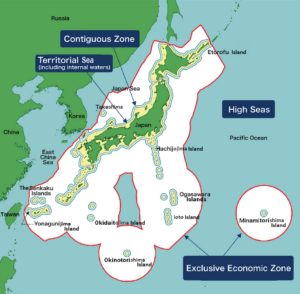 Their location is strategic for the Chinese Navy, which views the South China Sea as a “zone of vital interest”.
Their location is strategic for the Chinese Navy, which views the South China Sea as a “zone of vital interest”.
The prevailing impression is that, through this conflict, China seeks to assert its power and reactivate its claims on what it calls “its fundamental interests”
That’s why the Chinese navy is increasingly active inside what is called the first chain of islands, because it wants to have easier access to the high seas, to satisfy its new oceanic ambitions.
The problem is that China is surrounded by many Japanese archipelagos: to access the ocean space, it must pass through the Okinawa area.
Chinese seek to impose Japanese right of “innocent passage”
Innocent passage is a concept in the law of the sea that allows for a vessel to pass through the territorial waters of another state, subject to certain restrictions.
China intends to build a modern oceanic navy with unprecedented defense and projection capability.
But there is a dominant position of Japan’s territorial waters
Japanese proposal:
In the light of the case-law, a division of the waters concerned based on a median line constitutes an equitable solution.
Chinese proposal:
Geophysical peculiarities of the area must be taken into account then, the “natural prolongation” of the Chinese continental shelf extends to the Okinawa trench
Its main rival is the Japanese navy, which is essentially defensive, but equipped with modern boats and sophisticated anti-missile systems.
The location of the Senkaku Islands is strategic for the Chinese Navy if it wants to defend its “area of vital interest”.
The Chinese Navy can not reach any parity with the US Navy
And the US Navy controls the Strait of Malacca.
3.5.2. The Paracel Islands
 The Paracel Islands are an archipelago of coral islands in the South China Sea.
The Paracel Islands are an archipelago of coral islands in the South China Sea.
These islands have no significant military value, but geological studies indicate potential for large oil deposits in the surrounding waters.
In 1974 China got hold of the islands after a naval battle with Vietnam.
After reuniting in 1976, Vietnam again publicly called the Paracels.
This dispute is still going on.
China puts forward its claims in 1974, that means:
– After being admitted as a permanent member of the UN Security Council
– Just with the end of the Vietnam War.
3.5.3. The Spratley Islands
The Spratley Islands are an archipelago of coral islands in the South China Sea.
Spratley Islands contain oil, gas and the region’s largest fisheries resource
They are on the sea route of a third of the world maritime traffic.
The total area is approximately 5.3 km² spread over an area 500 km long and 400 wide.
These islands are claimed and occupied by 5 nations:
Vietnam: 13 islands 1600 soldiers
China: 9 islands 480 soldiers
Malaysia: 3 islands 180 soldiers
The Philippines; 5 islands 150 soldiers
Brunei: 2 islands 30 soldiers
Taiwan: one island (the largest Itu Aba) 250 soldiers
All are supplied from their country.
These islands are uninhabited because there is no arable land. The main island is “ Itu Aba”. There are no ports, but there are four aerodromes.
These crises have one advantage: they make Japan de facto the strongest counter-power to the hegemony of China.
This chinese displayed will is increasingly scares the neighbors.
The benefits are for Japan that it can count on the support of USA … and the sympathy of a part of Southeast Asia.
Dokdo
3.5.4 Tension due to Takeshima Conflict
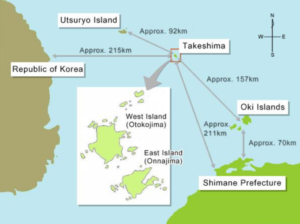 There is the dispute between Japan and the Republic of Korea over the territorial sovereignty of Takeshima,
There is the dispute between Japan and the Republic of Korea over the territorial sovereignty of Takeshima,
Japan claims that the occupation of Takeshima by the Republic of Korea was illegal and lacked an international legal basis.
It regularly challenges landings on the island of members of the National Assembly of the Republic of Korea and others, the military exercises of the Republic of Korea and the construction of buildings.
It proposed to Seoul to refer the issue of Takeshima to the International Court of Justice (ICJ) three times: South Korea has always refused.
3.5.6. Tensions due to the non-resolution of the dispute with Russia over the Northern Territories
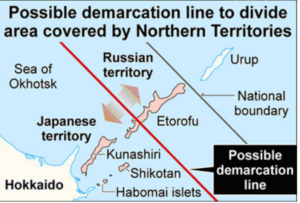 The issue of the Northern Territories remains one of the oldest disputes since the World War II.
The issue of the Northern Territories remains one of the oldest disputes since the World War II.
Japan has established a close dialogue with Russia at different levels. It was agreed that the two countries will carry out common economic activities on the four northern islands.
Japan will also implement humanitarian measures for former islanders.
Solving the problem of the sovereignty of the four North Islands will lead to the conclusion of a peace treaty.
6- The weight of history or the influence of Japan’s colonial past
Woman of comfort
This is the term for a system of prostitution set during the war to relieve Japanese soldiers in conquered countries.
Between 1931 and 1945, the Japanese army forcibly prostituted nearly 200,000 women, made available to its troops. Taiwanese, Filipino, Indonesian and, for the most part, Korean forced to “sexual service” in houses run by the Japanese army.
In 1942, while some 3 million soldiers are stationed abroad, a ministerial document lists 400 comfort stations – 280 in China, 100 in Southeast Asia, 10 in the Pacific archipelagos, 10 on the island. from Sakhalin.
This case still taints relations between Japan and other countries whose women are from, especially Korea and China.
In 2015, a UN committee called for the payment of adequate compensation for these sex slaves of the Japanese imperial army.
Japan says it has already presented “its most sincere apology and remorse”, including through “letters from various prime ministers over the years”.
“The government recognizes that the issue of comfort women has been an insult to the honor and dignity of so many women,”
An agreement concluded in December 2015 between Japan and South Korea, “the two countries have confirmed the definitive and irreversible resolution of the problem of comfort women”.
Japan had at the time paid one billion yen (7.5 million euros) to the Korean women concerned.
But there are still demands arising from time to time requesting adapted repairs and answering their need of dignity”
History books
History books in Japan, which discuss relations between China and Japan during the war (1931-1945), continue to maintain a climate of mistrust between the two countries.
China uses this element to propagate an anti-Japanese nationalist sentiment.
In general, this is happening the 18th of September, a date coinciding with the beginning of the imperial Japanese invasion of Manchuria in 1931.
The two powers use their historical differences to establish their regional projects and thus play the game of the nationalists.
Part of the Japanese nationalists (right wing) and revisionists use these facts to demonstrate the need to amend Article 9 of the Constitution, to build a real army and to get out of its defensive only position. These Japanese nationalists point to the crystallizations around the Senkaku Islands as well as the American and Chinese rivalry, to demand the annihilation of the spirit of Article 9 in force since 1946 instituting constitutional pacifism, thus prohibiting the acquisition of offensive weapons. But every body knows that Japan, since two decades, possesses one of the most powerful armies in the world (modern and well equipped) . And it must be remembered that Japan is considered a “nuclear threshold” country, which can, technically and theoretically, acquire nuclear weapons in a very little time frame.
Unit 731
Unit 731 is a Japanese military unit for bacteriological research. Between 1936 and 1945 it was responsible for the deaths of hundreds of thousands of people who were used as guinea pigs in various experiments. Later it will be found responsible for war crimes and crimes against humanity.
Conclusion:
The geopolitical challenges of Japan
1) Demographics
For the first time, projections show a significant decline in demographics.
This global evolution will be accompanied by a decrease of the active population and a sharp aging of its population and
Japan will become a country of immigration.
These changes in demographic parameters will change its geopolitical position both in its regional environment and in the global context.
As a result, the economic effects of the aging of the population and the costs of management of the gerontology phenomena will push the country logically to open the door to immigration[4].
Labor needs are particularly acute in the construction sector and for small and medium-sized enterprises.
Immigration, for cultural reasons, seems the least favorable solution. But demographic constraints could weigh more on internal and external geopolitical choices.
The hypothesis that Japan would succeed in offsetting the decline of its population by robots, sounds like a futuristic story, but this current change concerns only the economy.
Food Security
Population decline will offset issues related to food security as a progress in industrialization of urban agriculture continues.
Energy
The Japanese society based on massive robotization can not function without reliable energy resources.
So Japan will always remain dependent on geopolitical processes. It will be always beyond its control in the Middle East.
Nippon tries to protect its society by promoting research on alternative energies.
A rapprochement with Russia, a major producer of gas and oil, may be a solution if the issue of the Northern Territories is resolved.
Raw materials
Japan has several vulnerabilities regarding raw materials: it concerns the sources of energy that we saw above, but also its dependence on China for rare earths
Partners:
India
Tokyo is not able at all to penetrate the Chinese market and build a balanced partnership with Beijing. This for various reasons we saw above.
That’s why Japan has chosen a partnership with India, laying the groundwork for the so-called “Asia-Africa Growth Corridor”, also known as “Freedom Corridor”, in order to pool their economic complementarities.
Which opens to Japan the wider area of the Indian Ocean.
European Union
EU and Japan signed Jefta, “historic” agreement in response to Trump’s protectionism.
Called Jefta (Japan-EU free trade agreement), it creates a free trade area covering nearly a third of the world’s gross domestic product (GDP). It must be submitted to the European Parliament for entry into force in 2019.
US- Japan
No signal that Japan has a willingness to question its geopolitical strategy focused on an alliance with the US.
The American strategy in the region is based on the “Mclane Doctrine” dating back to 1853, which said “no power should be between the US and China”.
Currently, it is said that the US wants to keep Japan as an “unsinkable aircraft carrier” in perpetuity to “contain China”.
This suits Japan because it contributes to its own defense, but Tokyo is behaving more and more independently by progressively improving relations with Moscow and the European Union.
Nuclear power
Nuclear power remains one of the hot topics between the US and Japan.
A clear political difference emerged between Tokyo and Washington in bilateral consultations before a UN panel adopted a Japanese resolution this month calling for the total elimination of nuclear weapons. The United States had opposed any reference to Article 6 of the Nuclear Non-Proliferation Treaty (and subsequent NPT resolutions in 1995, 2000 and 2010).
In the UN resolution sponsored by Japan, the article calls on the nuclear-weapon States to pursue nuclear disarmament.
China, Japan and South Korea call for the complete denuclearization of the Korean peninsula. The North Korean nuclear bomb is in the minds of the leaders of these countries with very different motivations.
Should North Korea be declared a country endowed with the nuclear weapon the geostrategic posture of these three countries but also of US will change radically:
The scenarios studied by the strategists of these three countries and the US are two in number:
With or without reunification of the two Koreas:
1) With reunification: Japan will be surrounded by four nuclear powers: Russia, China, Korea and the US.
It will have to acquire nuclear weapons.
2) Without reunification: South Korea will not be able to tolerate this fait accompli which means an imbalance of strategic forces and will start the acquisition of this weapon (even if it happens without media hype).
Japan will have to acquire nuclear weapons.
But in both cases the US will be in an unfavorable position: the balance of nuclear terror in this part of the world, will render inoperative the presence of the American military bases.
UN Security Council
While Japan’s role and contributions to the UN and its agencies have increased since 1973, voices have been raised about a permanent seat to Japan at the UN Security Council (UNSC) . We can imagine the oppositin of Russia and China. An act like this can only happen when there is a complete change in the UN Charter.
[1] The international agreements and major international treaties that Donald Trump has questioned and would like to release.
By applying its slogan “America first”
– January 23, 2017, withdrawal of the Trans-Pacific Free Trade Agreement (TPP)
– 1 June 2017, withdrawal of the Paris agreement on the climate; (COP)
– On October 12, 2017, the United States withdrew from the United Nations Educational, Scientific and Cultural Organization (UNESCO);
– On 2 December, its withdrawal from the Global Compact for the Management of Migrants and Refugees;
– January 20, 2018, renegotiation of the Alena with Canada and Mexico.
– On May 8, 2018, the withdrawal of the United States from the Iranian nuclear agreement on Iran;
– Critique of Transatlantic Free Trade between the European Union and the United States (TTIP),
– Denunciation by the World Trade Organization (WTO)
[2] Koreans, for example, are motivated to learn Japanese and the Japanese are very attracted by music, fashion from Korea, also known as the “Korean wave”.
[3] A Japanese report released in 1994 estimates still at 3.26 billion barrels at most the potential of the deposits.
The China National Offshore Oil Corporation publishes a report in 2011 that shows the figures of 384.6 million barrels of oil and 303.7 billion cubic feet of gas for the entire East China Sea.
[4] The limited appetite of the Japanese for some jobs of this social behavior is referred to as the “three K’s”: Kiken (dangerous), Kitanai (dirty) and Kitsai (tiring).




